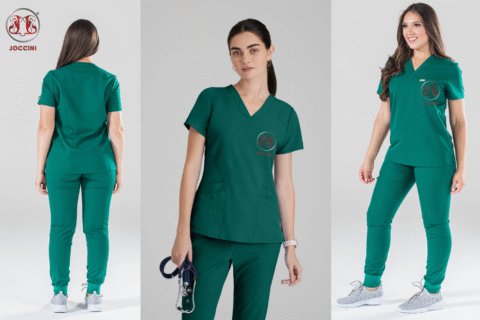
Scrub Colors & Their Meanings in Hospitals (2025 Edition)
- By admin
- 0 Comments
- Posted on
What Light Blue, Green, Red, Black & More Say About Medical Roles
Walk into any hospital and you’ll find a rainbow of scrubs in action. It’s not just fashion—it’s function. From calming blues to authoritative blacks and energetic reds, scrub sets colors serve a real purpose: helping staff and patients identify roles, creating psychological cues, and even influencing trust.
This guide isn’t fluff. It’s grounded in real-world studies and hospital practices. We’re going to explain what common scrub colors signal—and why those signals matter, whether you’re a patient, a pro, or both.
2. Color-Coded Scrubs: More Than Just Uniforms
Hospitals didn’t start using colors just to look good. Back in the early 20th century doctors wore white to show cleanliness. That soon changed—white reflected harsh lights and caused eye strain in the OR—so surgeons switched to green and blue for a calmer, less fatiguing work environment
Today, many hospitals use color schemes to identify roles. Nurses, technicians, surgeons—they each get a shade. It’s about quick visual recognition: a color-coded language that cuts confusion and speeds up patient care
No universal rulebook exists—every hospital sets its own codes—but patterns emerge across the profession.
Top Scrub Color Options for 2025 – From Joccini Workwears



3. Light Blue Scrubs: Friendly, Trustworthy & Everywhere
Light blue is perhaps the most ubiquitous scrub color. Nurses, maternity wards, OB/GYN, and even some general care units favor it. Why? Because blue is calming—it eases anxiety for patients and signals reliability. More than half of surveyed patients rated clinicians in blue scrubs as most caring and trustworthy
This makes it a go-to for patient-facing staff. It’s clean, feels professional, and aligns with traditional expectations of caregiving roles.
4. Green Scrubs Meaning: Surgery, Focus & Competence
Surgeons and OR staff lean toward greens and teals—and often still do. It’s not style, it’s science. Green sits opposite red on the color wheel, giving surgeons visual relief when staring at blood-stained tissue. It also reduces eye fatigue and helps prevent optical illusions in bright surgical lights
Research has shown that patients tend to associate green scrubs with competence and surgical roles more than other colors. In fact, green was the most frequently picked color when patients were asked to identify the surgeon in a photo lineup
Put simply: green looks credible in high-stakes environments—and patients subconsciously take note.
5. Red, Black, Grey & Other Scrub Colors: What They Signal in a Hospital
Scrubs aren’t just about hygiene. They carry messages—loud ones. Let’s break down what patients and hospitals interpret when they see red, black, grey, and more.
Red Scrubs: Attention-Grabbing and Rare
Red isn’t a go-to in most hospitals—and for good reason. It’s intense. Some ER teams or trauma units might wear it to convey urgency, but overall, it’s used sparingly.
From a psychological standpoint, red can trigger stress. A 2023 study published in Frontiers in Psychology found that patients rated clinicians in red as more aggressive and less caring than those in lighter colors. That said, some pediatric units experiment with softer red or coral tones to stand out in child-friendly environments.
So when you see red scrubs? Think high-alert roles or niche settings where visibility is key.
Black Scrubs: Authority Meets Minimalism
Now this one’s gaining ground. Black scrubs are sleek, confident, and—yes—controversial. Some see them as too stark or intimidating. Others say they convey professionalism and confidence.
According to a survey by TCTMD, patients saw black as more “commanding” than blue or green. It’s often worn by higher-level staff—think surgical residents, senior nurses, or hospitalists—especially in teaching hospitals.
When used well, black Jumpsuit Scrubs stand out without being loud. They signal someone who’s not here to play games.
Grey Scrubs: Neutral, Clean, and Professional
Grey flies under the radar—but that’s its strength. It’s often used for imaging departments, outpatient units, or admin-heavy roles. Not overly clinical, not overly emotional. Just… present.
Psychologists say grey strikes a balance between approachability and control. In other words, people take you seriously without feeling overwhelmed. If blue is the color of care, grey is the color of quiet competence.
Other Colors (Pink, Maroon, Burgundy, White, Yellow)
- Pink: Common in pediatrics or women’s health. It’s nurturing, soft, and warm. A 2022 color perception study from The Journal of Healthcare Design found patients in maternity wards rated pink-clad nurses as “most emotionally supportive.”
- Maroon & Burgundy: Deep tones like these are used by specialists or senior staff in some hospitals. They suggest experience and seriousness without the harshness of black.
- White: Once the classic, now the exception. White is usually reserved for lab coats or administrative roles today. It’s prone to staining and makes patients anxious in clinical settings.
- Yellow: Often used for custodial staff or isolation units. Its brightness makes it highly visible—useful in roles where cleanliness and accountability matter most.
6. What Scrub Colors Say About Medical Roles: From Surgeons to ICU Nurses
Here’s the thing—scrub colors aren’t randomly assigned. Hospitals often use color-coded systems to help staff, patients, and families instantly recognize who’s who. Let’s break it down role by role.
Surgeons: Green or Blue
You’ll almost always find surgeons in green or blue. Why?
These colors help reduce eye strain in the OR and make it easier to spot contrast—especially blood—on surgical gowns. It’s not just tradition; it’s practical. Studies from Johns Hopkins confirm that green helps reset the eye’s sensitivity to red, which is critical when you’re elbow-deep in surgery.
Green scrubs meaning in 2025? Surgical precision, experience, and clarity.
ICU Nurses: Navy, Hunter Green, or Grey
ICU nurses are typically dressed in darker, more grounded shades like navy blue or hunter green. Why?
Because they need to project calm under chaos. The ICU is where life and death play tug of war. Patients are at their most vulnerable, and family members are looking for stability. Navy and green colors signal reliability and focus.
What color scrubs do ICU nurses wear in 2025? Expect deep greens or navy with subtle institutional branding.
ER Staff: Bold Colors Like Royal Blue or Red
Emergency Room staff need visibility—fast. That’s why you’ll often see them in royal blue or, occasionally, red scrubs. These aren’t the soft pastels you see in pediatrics. These are vivid, loud, unmistakable.
The color helps patients and colleagues identify ER staff in a crisis. Red might feel aggressive, but when every second counts, it works.
Pediatric Nurses: Pink, Lavender, or Fun Prints
It’s not about style—it’s about psychology. Pediatric nurses wear softer colors to put children at ease. Lighter shades like pink and lavender trigger feelings of safety and warmth. In many children’s hospitals, nurses even wear cartoon-printed scrubs to build quick rapport with young patients.
Pink scrubs meaning in 2025? Comfort, care, and emotional support.
Lab Techs & Radiology Staff: Grey or Black
Grey and black are practical. These professionals work with chemicals, machinery, and digital equipment. Their scrub colors are meant to hide stains and maintain a “low-distraction” appearance. Grey also helps minimize glare in imaging rooms.
Grey scrubs meaning in hospitals? Precision, focus, and behind-the-scenes expertise.
General Nurses & Floor Staff: Light Blue, Navy, or Teal
The backbone of hospital operations. Light blue scrubs are by far the most common in nursing. They’re calming, clean, and highly identifiable. Navy or teal is used to differentiate between departments or seniority levels.
Light blue scrubs meaning in hospitals? Approachability, care, and patient trust.
7. Scrubs and Patient Psychology: What Colors Do Patients Trust?
Here’s where it gets interesting. Scrubs don’t just identify roles. They influence how patients feel about the people wearing them.
A 2021 clinical study published in BMC Health Services Research found that patients felt most at ease with healthcare workers in light blue and navy scrubs. Those colors were associated with kindness, competence, and trustworthiness. On the other hand, colors like red and black had a mixed response—seen as professional by some, but cold or intimidating by others.
So if you’re asking:
What color scrubs do people trust the most?
The answer is light blue, followed closely by navy.
It’s no coincidence hospitals standardize these colors. When someone’s life is in your hands, trust is non-negotiable. And color plays a role in building—or breaking—that trust from the first second you walk into the room.
Final Thoughts: Scrubs Aren’t Just Clothes—They Communicate
Here’s the thing—scrubs do a lot more than cover your body during a shift. They carry unspoken messages. The color of your scrubs can quietly tell patients who you are, what you do, and how you fit into the wider machine of a hospital.
A nurse in navy brings comfort and calm. A surgeon in green signals precision and control. A tech in grey is the unsung backbone behind the machines. These colors don’t just represent departments—they reflect trust, experience, and even emotion.
So if you’re picking scrubs or trying to understand what someone else’s color means… now you know. There’s a whole language in these fabrics—and once you learn it, you start seeing the hospital differently.
And while you’re here, two quick reads worth your time:
25 Best Scrubs for Women in 2025
Best Cotton Scrubs for Women in 2025
Trust me—comfort matters when you’re pulling 12-hour shifts.
Also, if you’re still wondering about the calming effect of surgical greens, this piece on Green Scrubs Meaning in 2025 gives you the full picture.
Frequently Asked Questions About Green Scrubs
Green scrubs are most commonly associated with surgical teams and operating rooms. The green color helps reduce eye strain during long procedures, contrasts well with the red color of blood, and minimizes visual fatigue. It also signifies sterility, calmness, and focus in high-stress medical settings.
Green scrubs are typically worn by surgeons, surgical nurses, and operating room technicians. In some hospitals, emergency room (ER) staff or anesthesiologists also wear green, depending on institutional dress codes.
Scrub colors often indicate roles or departments within a hospital. For example:
- Green = Surgery/Operating Room
- Blue = Doctors or General Staff
- Red or Maroon = Emergency Department
- Black = Admin or Management
- White = Lab or Senior Doctors
These codes may vary depending on the hospital or region.
Green scrubs are predominantly worn by professionals involved in surgical or pre-surgical settings—surgeons, OR nurses, and surgical techs. These roles require focus, precision, and sterile environments, which green helps maintain psychologically and visually.
While both colors are calming, green is more common in operating rooms due to its contrasting visibility with red (blood) and its aid in reducing eye fatigue. Blue, on the other hand, is often worn by doctors or general hospital staff. Both are considered professional and medically appropriate.
Green and blue are widely trusted due to their association with cleanliness, calm, and professionalism. Surveys often show blue scrubs as the most trusted overall, followed closely by green in surgical contexts.
Typically, patients do not wear green scrubs unless a hospital has specific color-coded gowns for particular procedures. However, in some institutions, green may be used for pre-op or post-op patients to signify surgical recovery.
In mental health settings, softer tones like light blue, pastel green, or beige are often used to create a soothing, non-threatening environment. These colors promote calmness and reduce anxiety in patients.
Yes, absolutely. Scrub colors are often part of a color-coded system to indicate roles, departments, or levels of access. This helps both staff and patients identify medical personnel quickly and efficiently.


